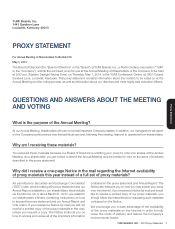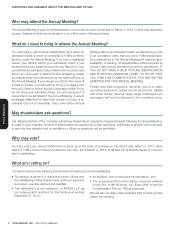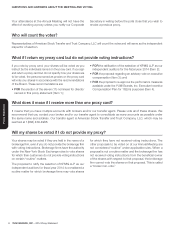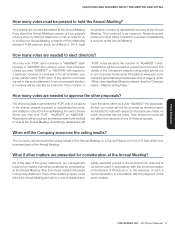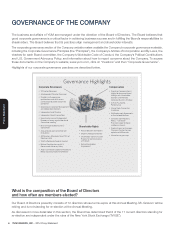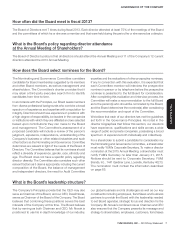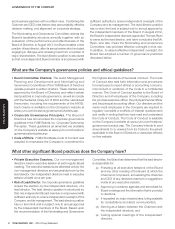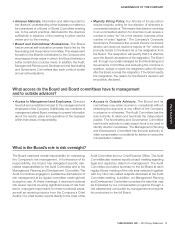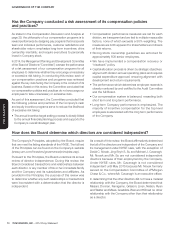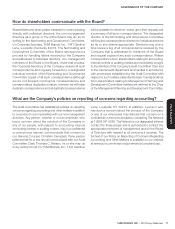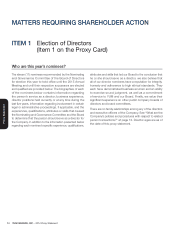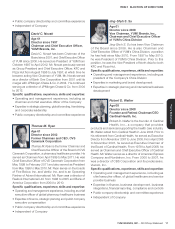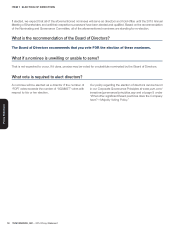Pizza Hut 2013 Annual Report Download - page 32
Download and view the complete annual report
Please find page 32 of the 2013 Pizza Hut annual report below. You can navigate through the pages in the report by either clicking on the pages listed below, or by using the keyword search tool below to find specific information within the annual report.
YUM! BRANDS, INC.-2014Proxy Statement10
Proxy Statement
GOVERNANCE OF THE COMPANY
Has the Company conducted a risk assessment of its compensation policies
andpractices?
As stated in the Compensation Discussion and Analysis at
page 29, the philosophy of our compensation programs is to
reward performance by designing pay programs that incorporate
team and individual performance, customer satisfaction and
shareholder return; emphasize long-term incentives; drive
ownership mentality; and require executives to personally
invest in Company stock�
In 2014, the Management Planning and Development Committee
of the Board of Directors (“Committee”) oversaw the performance
of a risk assessment of our compensation programs for all
employees to determine whether they encourage unnecessary
or excessive risk taking� In conducting this review, each of
our compensation practices and programs was reviewed
against the key risks facing the Company in the conduct of its
business� Based on this review, the Committee concluded that
our compensation policies and practices do not encourage our
employees to take unnecessary or excessive risks�
As part of this assessment, the Committee concluded that
the following policies and practices of the Company’s cash
and equity incentive programs serve to reduce the likelihood
of excessive risk taking:
•
The annual incentive target setting process is closely linked
to the annual financial planning process and supports the
Company’s overall strategic plan.
•
Compensation performance measures are set for each
division, are transparent and are tied to multiple measurable
factors, none of which exceeds a 50% weighting. The
measures are both apparent to shareholders and drivers
of their returns.
•
Strong stock ownership guidelines are enforced for
approximately 600 senior employees.
•
We have implemented a compensation recovery or
“clawback” policy.
•
Capital allocation process is driven by strategic objectives,
aligned with division annual operating plans and requires
capital expenditure approval, ensuring alignment with
development and return requirements.
•
The performance which determines employee rewards is
closely monitored by and certified to the Audit Committee
and the full Board.
•
Our compensation system is balanced, rewarding both
short term and long term performance.
•
Long-term Company performance is emphasized. The
majority of incentive compensation for the top level
employees is associated with the long term performance
of the Company.
How does the Board determine which directors are considered independent?
The Company’s Principles, adopted by the Board, require
that we meet the listing standards of the NYSE. The full text
of the Principles can be found on the Company’s website
(www.yum.com/investors/governance/principles.asp).
Pursuant to the Principles, the Board undertook its annual
review of director independence. During this review, the
Board considered transactions and relationships between
each director or any member of his or her immediate family
and the Company and its subsidiaries and affiliates. As
provided in the Principles, the purpose of this review was
to determine whether any such relationships or transactions
were inconsistent with a determination that the director is
independent.
As a result of this review, the Board affirmatively determined
that all of the directors are independent of the Company and
its management under NYSE rules, with the exception of
David C. Novak, Jing-Shyh S. Su and Michael J. Cavanagh.
Mr. Novak and Mr. Su are not considered independent
directors because of their employment by the Company.
Under NYSE rules, Mr. Cavanagh is not considered
independent until May 2015 because Mr. Novak formerly
served on the Compensation Committee of JPMorgan
Chase & Co., where Mr. Cavanagh is an executive officer.
In determining that the other directors did not have a material
relationship with the Company, the Board determined that
Messrs. Dorman, Ferragamo, Grissom, Linen, Nelson, Ryan
and Walter and Mses. Graddick-Weir and Hill had no other
relationship with the Company other than their relationship
as a director.



